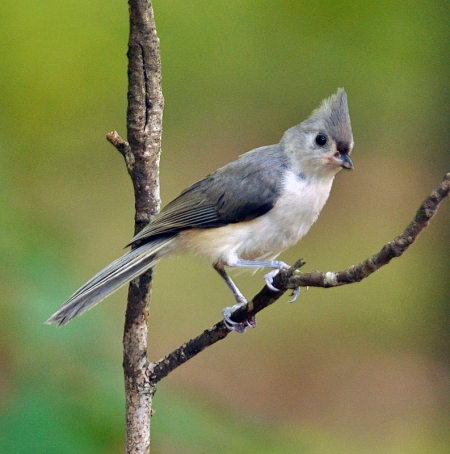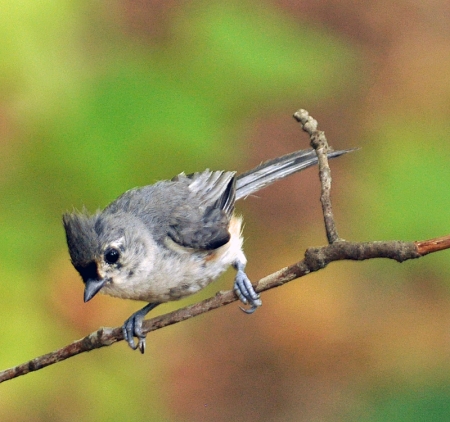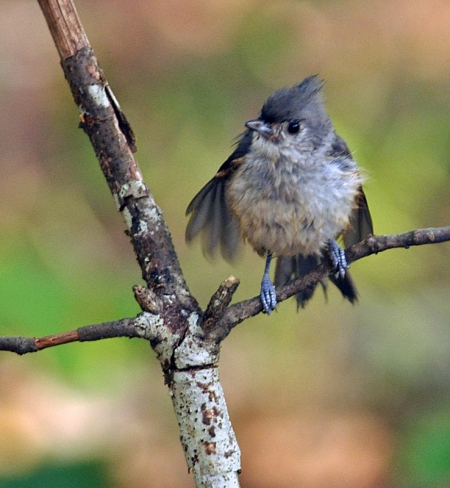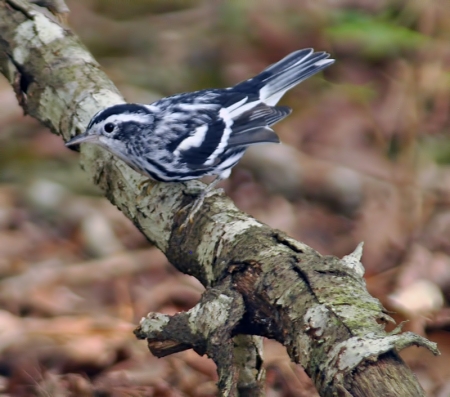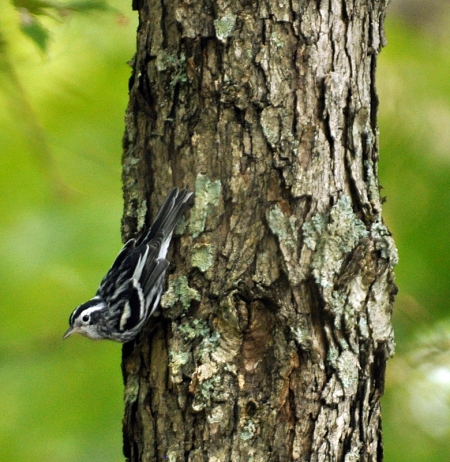Like most of the rest of the country, it’s been really hot and dry here in the Ozarks this summer. And summer started in March. It’s actually been as dry as I’ve ever seen it in my 45 years, so with no permanent sources of water for miles, other than scattered stock ponds, it seemed like a good time to place a bird bath in the woods near the house with a portable blind situated close by and see what showed up.
The bird bath itself is quite simple. A shallow depression holds a glass pie plate so that the lip of the plate is at roughly ground level. A gallon milk jug of water is suspended from a tree branch six feet above the plate, a pin hole in the bottom sloooowly dripping water into the pan, since birds are attracted to the sound of running, dripping water.
I tried sitting in the blind a couple of times, always late in the evening, but found it to be very hot and stifling even with all of the flaps open. I think the sweat dripping from my head was making more noise than the water coming from the milk jug. So the blind was abandoned, at least for the time being.
I kept an eye on the bath — a small group of titmice were using it regularly, but not much else it seemed. This time I’d seen the titmice heading in the direction of the bath and tried to head them off and get into the blind before they arrived. That didn’t work out and I ended up hiding behind a tree, thirty feet away.
There were five titmice, a family group I’m guessing. I know they could see me, but they didn’t seem to care, dropping to the water, grabbing a drink and vigorously splashing about. Afterwards, it was back to the (carefully placed) dead branch to shake off the excess water and maybe preen a little.
The titmice had moved back into the trees and I was thinking it was time to move on when a male Black-and-white Warbler appeared on the dead branch. I was tickled as I shot twenty or so quick frames with high hopes for at least one really good shot. But none of them had the sharpness that the titmice photos did, despite the fact that the warbler was a couple of feet closer. Very frustrating.
The warbler never did actually use the bath and soon moved back into the trees. A few minutes later I spotted him working his way down the trunk of a white oak and showing why the species used to sometimes be called the Black-and-white Creeping Warbler, a cumbersome if accurate name.
The Black-and-white Warbler is a common summer resident in the mixed and deciduous forests of the eastern United States and a broad swath of Canada. The species has an unusually large wintering range: southern Texas and the US Gulf Coast, down through Mexico and Central America to Ecuador, Columbia and Venezuela.
It feeds on insect and spiders procured from the foliage and bark of trees as it moves around like a nuthatch or creeper. Unlike either of those two however, the Black-and-white Warbler moves freely both up and down. It will also occasionally dart from a perch to catch an insect in the air, much as a flycatcher will do.
The Black-and-white Warbler typically arrives in southern Missouri in mid- to late April and gets about the business of reproducing. The male’s song sounds, to me at least, like a squeaky wheel, very highly pitched. The female builds the nest in a depression in the ground, typically at the base of a tree, stump or downed log. It’s constructed of grass, dead leaves, pine needles, etc. and lined with hair, rootles and fine grasses.
Four or five eggs are incubated for ten or eleven days, solely by the female. After hatching, the nestlings are fed by both the male and female and fledge after eight to twelve days. Only a single brood is produced each year.
Black-and-white Warblers are very much birds of the forest interior preferring a closed canopy with a well developed understory and a low density of shrubs. A forested block of around 300–700 acres is needed to sustain a viable breeding population, the species is intolerant of forest fragmentation and not usually found in forests smaller than 175–200 acres. They do show up in smaller woodlots provided there are more extensive forests nearby which accounts for them showing up regularly on my almost 20 acres, surrounded on three sides by shrubby fields and second growth but connected by a wooded corridor to a large block of US Forest Service land.
Next up, probably more warblers. Or maybe I’ll tell you about my misadventures from this morning.
| References: |
|
Baicicich, P.J. and Harrison, C.J.O. 1997. A Guide to the Nests, Eggs, and Nestlings of North American Birds, 2nd edition. Academic Press: San Diego. |
| Crawford, H. S., R. G. Hooper, and R. W. Titterington. 1981. Songbird population response to silvicultural practices in central Appalachian hardwoods. Journal of Wildlife Management 45:680–692. |
| Galli, A. B., C. F. Leck, and R. T. T. Forman. 1976. Avian distribution patterns in forest islands of different sizes in central New Jersey. Auk 93:356–64. |
|
Jacobs, Brad and James D. Wilson 1997. Missouri Breeding Bird Atlas: 1986-1992. Missouri Dept. of Conservation, Jefferson City. 430 pp. |
| Robbins, C. S. 1980. Effect of forest fragmentation on breeding bird populations in the piedmont of the mid-Atlantic region. Atlantic Naturalist 33:31-36. |
| Thompson, F. R., W. D. Dijak, T. G. Kulowiec and D. A. Hamilton. 1992. Breeding bird populations in Missouri Ozark forests with and without clear-cutting. Journal of Wildlife Management 56:23–29 |
| Whitcomb, R. F., C. S. Robbins, J. F. Lynch, M. K. Klimkiewicz, B. L. Whitcomb, and D. Bystrak. 1981. Effect of forest fragmentation on avifauna of the eastern deciduous forest. In Forest Island Dynamics in Man-dominated Landscapes. Ecol. Studies, vol. 41 (R. L. Burgess and D. M. Sharpe, eds.), pp. 125-206. New York, NY: Springer-Verlag. |
